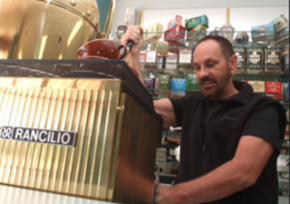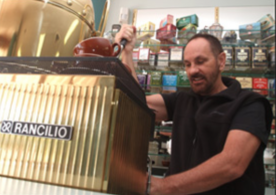 This information is designed to give you insight into just how important systematically tapping into the
This information is designed to give you insight into just how important systematically tapping into the
power of word of mouth could be for your business.
In fact, it could literally double your business for very little cost!
You’ll also find out how to construct a referral system that will harness the marketing power of word of mouth for your business. A referral system that means everybody wins—your customers and clients, your business, and those people referred. You’ll see some real-life examples of systems that work and work well.
Do you have a sleeping giant within your business? And some examples for you...
We all know that often, when we’re looking for a particular product or service, we usually don’t have a particular supplier in mind. We may browse google or scan the local newspapers, but more often than not, we’ll rely on advice and recommendations from friends or colleagues.
A massive amount of business is generated this way every day.
In fact, when asked, most business owners or managers would say that a great percentage of new leads or new inquiries come from ‘word of mouth’ or ‘referral.’ That is, your happy customers or clients talk about you in a positive way that means they’re literally sending people to your door.
Many business owners would estimate as much as 70% of new sales comes from this source.
And that’s fantastic. Fantastic because it clearly means your customers are happy with your service, the quality of your products or services, the value they receive for money, the way your team deals with them, and so on.
But it’s not so great, too, because any way you look at this, you’re still at the mercy of your customers. That is, it’s totally up to their discretion whether they talk about you. You don’t know who your clients talk to, or when, or even what they say. Worse yet, you don’t have any control over when, or even if, the potential clients contact you.
Those issues mean that you have no control over those referrals.
And this could mean that you’re missing a massive marketing opportunity within your business.
You see, if some clients are happily talking about you, that usually means plenty of others would be willing to do the same, with a little encouragement.
Better yet, you’ve probably heard the saying ‘birds of a feather flock together.’ Thinking about your own friends and associates, you’d probably have to agree that’s true.
It’s therefore fair to say that the clients you’re currently dealing with now very probably associate with like-minded people. People who are in a similar income bracket and have similar interests, hobbies, buying habits, ethical and moral beliefs, and often similar personalities.
Better yet, people in decision-making roles who purchase from you tend to know other people within their sphere of influence or industry who are your ideal potential clients.
Given that, then, the active customers you like dealing with, who enjoy working with your business, more than likely know other people like them who could have a truly similar need for your products or services.
And therein lies your ‘sleeping giant.’ A giant you can harness by creating a structured way of ‘capturing’ these referrals from all your customers…a referral system.
A system that means you have a way of asking every customer to refer other customers to you. In this way, referrals no longer come to you by chance or default. Instead, it’s a predictable, ongoing process.
This suggestion often deters people because they don’t want to be seen as too ‘aggressive.’ Do NOT look at this strategy that way. If it’s true that most of your customers are happy with your business and the products and services you sell, then it follows that most would be quite happy to refer you, given an easier opportunity to do so. In fact, a systematised referral system merely provides your business with a way of rewarding people for what they’re currently doing (referring people) and encouraging them to do that more often!
Let’s review what could happen...
Regardless whether your base of ‘active,’ happy customers numbers10, 50, 2,000, 5,000, or 15,000, what would happen if you asked every single one of them for a referral to another customer?
Hypothetically, you could literally double your client base, couldn’t you?
Even if only 50% of your customers actually referred people to you and then only 25% of those people actually purchased, you’d still be ahead, wouldn’t you? In this example, you could have added a quarter more to your client base for very little cost. (Of course, these figures will change, depending on your type of business and the quality of your referral system.)
In fact, the percentage of people referred to you who actually purchase would usually be higher. You see, one of the reasons referral systems work so well is that often, when people are referred to a business, they are no longer ‘shopping around.’
The person who refers them to your business would usually be someone they trust—a friend or colleague whose opinion they value. And because of that trust, many simply won’t feel the need to compare your business with your competitors.
Given that, it no longer becomes a decision of ‘will I buy from this business?’ rather ‘what will I buy from this business?’ Statistics show people who have been referred to you are 4 times more likely to buy from you!
Another important benefit of a referral system is that the quality of your clients can be improved. Because like attracts like, there is absolutely no point asking for referrals from those customers you or your team members DON’T enjoy dealing with or who just aren’t profitable! That will only bring you more people like them.
So the clients you should target to ask for referrals need to be A and B—ideal clients, people who will bring more of your preferred types of clients. These ideal clients are the kinds of people who buy from you regularly, who spend well each time they do, and usually pay on time. They are the type of customer you enjoy dealing with, who appreciate what you do for them.
A referral system means that the cost of acquiring a new client is much lower than normal, especially when you look at how that referral system is structured. Let’s review that area now.
The first and easiest way to gain referrals is to ask for them! If people are doing it on their own, imagine what could happen if you were to ask every client to simply send more people to you. Another method is to use referral cards and/or thank you or nurturing letters to generate referrals. (You’ll see some examples of these throughout this handout).
The key to creating a referral system that works is to make sure everybody wins. To do that, sometimes the referrer needs to be rewarded for sending someone to you, and the refer-ee’ (the person who’s been referred to you) must be given some sort of incentive to test your business. Last but not least, obviously, your business must win out of the process, too.
 The"Mad Dentist"
The"Mad Dentist"
A perfect example of just how well this strategy works, is the referral system of Patti Lund, the Brisbane based dentist. Paddi has managed to transform his dental business into a place where people love to come.
One of Paddi's primary goals was to create a "happiness filled" working enviroment. Since Happiness was Patti's goal, he decided he didn't need to continue to work with customers who didn't bring any happiness into his business.
He split his clients into A,B,C and D groups, and then promptly sacked (by referring them to another dentist) his 'D' clients.
He then realised his 'C' clients had now become his 'D' clients, so he sacked those as well. and then followed the same pattern with his 'B' clients.
Consequently, he was left with only around 30% of his former client base. The 30% who were always on time, paid promptly, and were just a pleasure to deal with generally. And he loved it!
At the same time his team were concentrating on serving their 'A' clients with extraordinary care, even providing them with complimentary muffins on their visit to the surgery. They also began to ask as part of an agreement with their clients for referrals.
The outcome of all of these somewhat radical, unorthodox changes is a practice that gradually moved from a client base of 20% 'A' clients to a base of 100% 'A' clients.
Paddi and his team have been very successful in generating "word of mouth" advertising by carefully selecting the clients they are going to ask for referrals.
Another thing, Patti's Dental Practice is very definitely "by invitation only". Because Paddi and his team have many internal systems to ensure their customers are delighted, clients are thrilled to have the opportunity to refer a friend.
The entire system is done with a great deal of ceremony, which adds to the clients feeling of being 'privileged' to be selected to refer a friend. The referring client is given a set number of specially printed business cards(in a beautifully engraved gold business card holder), and knows that whoever they refer should be "just like them"
Human nature being what it is, leads to Patti's clients being very selective about whom they refer to the practice.
The end result for Patti Lund is that he now works a 22-hour week (as opposed to the 60 hours he was regularly putting in). He now earns approximately 3 times the average dental income, and they have a completely stress free, fun working enviroment.
How to Set up A Referral System
Depending on your business, the referrer may need to be rewarded with something tangible for sending someone to you. Usually the more tangible the better!
For example, you could offer a credit to their account for every potential customer who phoned or came into your business, mentioned your customer’s name, and purchased. This credit could be valued at $5, $10, or $200, depending on the value of your average sale. It could be a real incentive to get them to talk about you. (This also ties them back into buying from you next time!) Or they could receive something simple, like movie tickets, dinner for two, or some free special reports valued at a certain amount.
Sometimes an unexpected ‘thank you’ gift of those movie tickets or dinner can be even more powerful. This could simply be hinted at in the marketing material you use to promote your referral system.
For example, you could send a letter to your clients suggesting…
‘Every time a new customer purchases and mentions your name, the team here at [your Business Name] would really appreciate it. So much so that we’ll keep track of it so we can send you a little something to say thank you.’
For some, it could be the opportunity to give something to a friend or associate that will be of value to them. For example a letter might describe…
‘Every time an associate of yours makes an inquiry, visits the business, and purchases, they will receive a free gift [special report, consultation, product, service] valued at $XX.00. We’ll explain that you’ve arranged that especially for them. That way, they’ll want to give you a pat on the back and say thanks!’
Alternatively, the ‘reward’ could simply be your firm’s newfound ability, as the business grows, to increase the quality and depth of the products and service provided to that client.
For example, a service business might ask for referrals in the following way:
‘Our aim in life is to be able to continually offer you more and better service throughout every area of our business. To do that, you’ll understand that the business needs to keep on growing.
To add to that consideration, we like dealing with people like you. You make doing business enjoyable and rewarding. [Client Name], we know, too, that like people travel in groups. For example, you may know other people in similar situations or positions who could have a similar need or gain some value by working with us. That’s why we’ve found one of the most effective ways to be able to offer you more and better services and grow our business is through referral, or ‘word of mouth.’
To do that, once you’re 100% happy with the services you receive—and only when you’re happy—we’ll ask you for at least one qualified referral to another person like you.’
Or a professional practice of some sort might ask for referrals right from the very start. They might say something like this to every new client:
‘[Client name], to give you a double-edged guarantee, we do like to ask for just one thing from you. And that is, when and only when you’re 100% happy with the services and products we provide, we’ll ask you for at least one qualified referral to another person like you. A person in a similar position [your customer type, e.g., business owner, operations manager, factory foreman] who you think could gain value from the sorts of services we offer.
The reason I say this gives you a double-edged guarantee is that by doing this, we have a vested interest, over and above the norm, to do a great job. Obviously, we will want to make sure you’re really very happy. That way, we know, too, that our business will grow.’
Remember, fundamentally the person who is asked to make the referral will only cooperate if he or she believes that it’s in their best interest to do so.
These strategies work very well in smaller or service-based businesses, where you’re working closely with your clients. But what about a larger, high-volume business that may not have the same opportunity to get to know individual customers?
Like, for example, a supermarket, an airline, or a credit-line provider. In fact, it can work just as well, if not better. Larger high-volume and turnover businesses often have even easier ways at their disposal to gather referrals. Ways like offering bonus points or some sort of frequent user rewards. (If you have a small business, these sorts of ideas can be adapted to suit you, too).
A great example of just how effective this can be is a strategy used by airlines—the ‘frequent flyer’ programs. In this example, if you were referred to the program by an existing member within a certain time frame, both you and the referring member receive 1,000 bonus frequent flyer points. A very attractive proposition for all parties involved!
These types of promotions can be strategically planned to fill trading slumps throughout the year, when previous trends have shown that business is slower than you would like.
You can also take it a step further—referral systems can be arranged between businesses, such as that airline just discussed and, for example, the Diners Club credit card. In this great example, the referrer was offered 1,000 bonus frequent flyer points through that airline. And the cream on top of the whole deal was the chance for either the referrer or the refer-ee to win 1 of 6 all-expenses-paid international trips.
Further, using letters and/or referral cards when you’re ready to gather that referral (when you know your customers are happy with you) is a great tool. At this point, it’s important to reward the refer-ee. (Your Results Accountant will review customer feedback systems at another Businesses Getting Results meeting.)
The refer-ee
The refer-ee must be made an offer that gives them an incentive to call and a chance to test your business.
In the Diners Club example mentioned earlier, all newly referred members received a complimentary night’s accommodation at a particular hotel chain, with the option of a further 2 nights’ accommodation at hugely reduced rates. And the chance to win that overseas trip.
For example, you could create referral cards—business-card-sized promotion pieces outlining the benefits of dealing with your business, including a ‘reward’ to encourage contact. You distribute these cards to your most valued clients and encourage them to give the cards to their friends and associates.
To give you an idea, the cards could simply say something like this:
A Special Gift for You from a Friend
Valued at $XX.00
This card entitles you to some very special treatment at [Business Name]. Simply present this card and, thanks to your associate, you will receive a free [product, service, report] valued at $XX.00 with any purchase. This [product, service, report] will [save you time and hard-earned dollars, mean you can relax knowing XYZ is taken care of, introduce you to a whole new way of doing ABC, and so on]!
The back of the cards could present something like this:
With compliments from:
______________________________
[Name], I’ve been working with [Business Name] for some time now, and I’ve found them to be excellent in both what they do and the service they provide. So much so, I thought you might be able to benefit, too. So please do take advantage of this offer. It could mean getting better results from your [business type—hairdresser, accountant, banker, local store]. Hope this helps.
These cards could even be handed out over the counter in a retail environment. Or they could be attached to a letter that explains the way the referral system works and thanks them for being a customer.
Dear Jill,
It’s not often enough that we thank our clients—and I think it’s high time we did!
Recently, in an effort to improve our business, we’ve been measuring what we do and found that most of our business comes from word-of-mouth referrals from customers like you.
We’ve been trying to think of a way to thank you for referring business to us and have come up with the little cards enclosed.
Each time you refer a new customer to us, just give them a card with your name written on it. When they give it to us, we’ll send a little something to you. Make sure you tell them to pass it on to us, because when they do, they’ll get a little something extra, too, for becoming a new customer.
It’s our way of thanking you for your faith in us and for helping us to thrive in business. Only then will we be able to offer you even more and better products and service.
Kind Regards,
John Smith
PS If, by chance, you run out of the cards, just let us know and we’ll forward you some more.
Another important point is what to do when that refer-ee finally arrives at your doorstep. They’ve been referred to you…now what do you do?
The initial impression a brand new client gains may make or break their decision to stay with you.
For instance, there are files all over the floor, the phone seems to ring constantly, you haven’t had time to get the filing up-to-date for weeks, and no one is at the reception desk to meet them, and so on. That first impression suffers. Even if they’ve heard you’re the greatest thing since sliced bread, how are they going to feel about you now?
A little less confident, certainly.
Likewise, you walk into a new drug store because you’ve been told they’re the best in town. You discover an unattended pharmacy, boxes of stock half unpacked, and nobody’s there to help you. You’d be disappointed, wouldn’t you? But if you found a neat, orderly store with stock clearly displayed, you’d feel more comfortable shopping there. Better yet, there’s a full-time pharmacist and polite, trained assistants ready to help. And to really make an impression, imagine if you were given a glass of mineral water or orange juice while you waited.
One of the first things that works very well is to really welcome that new person into your business. For example, a business, perhaps a wholesaler, might handle a new refer‑ee’s inquiry like this:
‘Oh great, thank you for calling and welcome to [Your Business Name]. My name is [speak your name] and yours is…? Great, [Client Name], thank you for taking up the offer arranged for you by your associate and giving us a call. We really do appreciate it.
Since you’re new to [Your Business Name], what we’d like to do is to make a special time for you to come here and meet the team. When you come, we’ll sit down and talk about your needs over a cup of coffee or tea. Then I’ll [or the appropriate team member] take you through the premises, show you how our business works to meet your needs, and introduce you to some of the team.’
A retailer could do something similar in that when a refer-ee steps into the store and hands over a referral card or mentions a referrer’s name, they hear something along these lines:
‘Oh great, welcome to [Your Business Name]. My name is [Your Name] and yours is…? Great, thank you for coming in and taking up the offer arranged for you. We really do appreciate it. Since you’re new to the store, what we’d like to do is to show you around so that you know where to find everything. That way, shopping here will be easier for you. While we do that, I can explain our guarantee and a few other pointers about shopping here, like our customer club and lay-away plan. Do you have a couple of minutes now?’
 For a service business, professional firm, or virtually any kind of business, you could give a ‘Welcome to [Your Business Name]’ pack. (Imagine the shock if you got a pack like this from a retailer!) This pack could contain benefit-oriented information to clearly show the differences between you and your competitors and what to expect by working with you.
For a service business, professional firm, or virtually any kind of business, you could give a ‘Welcome to [Your Business Name]’ pack. (Imagine the shock if you got a pack like this from a retailer!) This pack could contain benefit-oriented information to clearly show the differences between you and your competitors and what to expect by working with you.
An example of this comes from a health professional—a welcome pack is sent to referred customers before their first meeting. The folder itself matches the type of clientele being referred and sets a high standard from the first instance. The folder includes the following sort of information:
· A map showing how to find the practice
· What they can expect upon arrival
· Some tips on preparing for the visit
· Some tips on healthy eating
· A little history of the practice
· A profile of the team members
In these instances, the new client has some information about your business and, possibly, an understanding of what to expect from your business relationship.
It can also be a good idea to acknowledge the person who brought the two of you together. It helps to show you’re grateful and looking forward to working with them. AND it is common ground you both have at the early stage of the relationship. Any common ground is good when you’re laying the base of a new business relationship.
Imagine the positive response something like those scripts would have in any business! Good. Very few businesses out there actually welcome new customers. And what a good idea. That person had a choice and chose (thanks to your referral system) to come into your business, so why shouldn’t we thank them for that choice, welcome them into the fold and make sure they understand immediately that your business is different, better, than your competitors?
One final point...
It is critical that your referral system match your potential customer types. That is, it must be attractive to the kind of people whom you deal with. They must like the offer, they must find it appealing, and it must match your positioning in the market.
For example, if you sell-high ticket items or if you offer something exclusive, your referral system must match that market and so follow that exclusive feel all the way through. Conversely, if your business is built on a budget image, your referral system needs to match that theme.
No matter which way you do it, the important thing is to do it! Create a system and use it over and over.
And finally, how far you want to take referrals is completely up to you. One successful retailer became so committed to dealing only with customers who were referred that he literally closed his doors. You could visit the store only by referral and on appointment. Another very different dentist generated new A clients ‘by invitation only.’ That is, you could visit him only if you were invited by another client.
So, how central referrals become to your business is something you need to consider. Regardless, it’s important to have a system to help you continually generate referrals. That way, sales will go up and marketing costs will go down!
In summary, if you're an ambitious business owner looking to boost your current results or if you're looking to get your clinic off to a flying start we invite you to contact us today. You can expect practical business, tax, marketing and financial advice that could have a profound effect on your future business profits. To book your FREE, one hour introductory consultation simply call us on (03) 9326 1244 or complete your details in the box at the top of this page and we will be in touch.
Tolevsky Partners - Build Your Business & Grow Your Wealth














